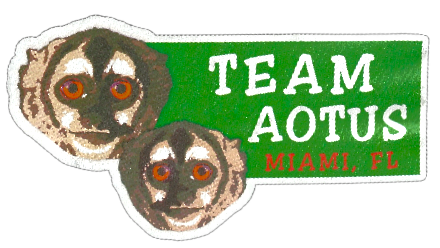
Background Information
Owl monkeys, also known as douroucoulis or night monkeys, (Genus: Aotus) are the only nocturnal monkey.They are small New World monkeys also known as platyrrhines , usually around a kilo (2.2 pounds). They live in small monogamous territorial family groups. The males and females are the same size and are remarkable difficult to sex (i.e. they are sexually monomorphic). Owl monkeys typically live high in the canopy of rainforests making them very difficult to study in nature. They usually sleep in the hollows of trees for protection during the day. They feed on a wide variety of food items but are primarily frugivorous but enjoy foraging for insects and lizards during the night .
The colony of owl monkeys housed at the DuMond Conservancy, founded in 1986, has offered an exceptional opportunity to study the behavior of a New World monkey. Located in South Florida, DuMond Conservancy houses the largest captive colony of owl monkeys outside of laboratories. The conservancy has provided interdisciplinary training in research methods to undergraduate and graduate students as well as extensive outreach opportunities to the local community. Our current research focuses on aspects of reproductive biology and communication that are difficult to explore in wild populations. From an outreach perspective, we regularly share our findings with the local community who collaborate with us in providing quality care and enriched enclosures for the owl monkeys. We have created an integrated program where science, public education, and advocacy advance owl monkeys as a flagship species for promoting the preservation of tropical rainforest biodiversity.
Geographic Distribution
Owl monkeys are widely distributed in the New World from Panama in the north to Argentina in the south. Originally, all owl monkeys were believed to belong to one species, Aotus trivirgatus, but now there are believed to be as many as 12 to 13 different species of owl monkey. The majority of the owl monkeys that we study at the DuMond Conservancy are Peruvian in origin, Aotus nancymaae.

